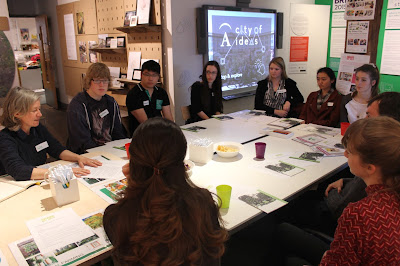On the last day of the #Livebuild, we had a long list of things to complete. We had to complete the roof, which we couldn't do the day before because we ran out of the OSB sheets which we had used to make it. We also had to apply a layer of clay mixture, to serve as a seal for the straw bales, before applying a plaster layer of cob on top of that clay to fully seal the straw bales and allow us to smooth the wall down. This task was aided by the fact that we had already started applying the clay base layer on some of the straw bales the day before and even more so by the extra number of people we had on site volunteering their time to apply the cob onto the bales.
 |
| Some of the young volunteers getting their hands dirty and putting cob on the wall. |
We had a lot of people on site helping us with the "cobbing". But we also had to work around all those extra people to complete the roof. Because of health and safety concerns, we decided against carrying out high level work on the roof whilst we had that many people on site working on the cob wall. This, in turn, pushed our schedule further back a little because we couldn't do both at once. However, we had a lot of fun mixing the plaster for the walls, a process that involved using our feet to mix all of the ingredients to make the plaster.
 |
| Amy and Jodie getting in on the fun |
Once we had the walls covered with the cob and we had gotten down to a few volunteers, we were able to get back to the roof, adding brackets and joints to improve the strength of the structure to make sure it can take the weight of the living roof.
 |
| A brief discussion before fixing the joints into place. |
As the daylight began fading, we realised that we still had a lot to do but not enough time to get it all done on Friday. So we focused on getting the OSB sheets fixed in place on the roof and the cob on the straw bale wall. By 8:30pm on Friday, we had managed to get all the sheets of OSB fixed in place and all the plaster on the wall. We even had time to sit round and have a celebratory pizza!
So after the end of the Big Week, we had completed the structure, but we still had a few things to sort out before the celebration evening 10 days after that Friday. A few of these were embellishments to the design, like putting down flooring inside the shelter, and few others were an important parts of the design, like adding more support to the structure on the sides to stop it from swaying horizontally under any heavy loads i.e. the living roof. We also have to put down the several layers of membranes and carpets before putting the soil on top of the structure, perhaps one of the most urgent items on the list because we had a seed bombing of the roof event planned on the celebration evening after the official ribbon cutting. All of which we will have to return to the site sometime between now and the celebration evening to do. Hence why we technically finished.
As we are at the other side of the project, looking back at the scale and ambition of the project it seems like we had the right idea. We had spent a lot of our time on site discussing ideas in order to overcome problems that had come up, mainly the lack of materials and sometimes a concern for the rigidity of the structure. This constant back and forth of ideas made the project feel much more open to everyone involved, as everyone managed to throw in some of their ideas into the mix. It also allowed me and the younger volunteers an insight into the thought process that goes into making a space, especially those who didn't have any practical experience with Architecture or even construction.
So, we did it!
Still a few kinks to straighten out and so it's all hands on deck to get everything ready for the ever important celebration evening!
So, we did it!
Still a few kinks to straighten out and so it's all hands on deck to get everything ready for the ever important celebration evening!







































